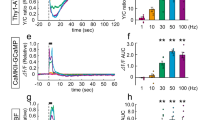Abstract
Neural information processing is tightly coupled to both energy consumption and derivation from substrates. In this study, the energy function of the neuron during the action potential (AP) is described and analyzed. It has been observed that energy consumption during the AP does not match predictions of the conventional theory of neural energy dynamics. On short time scales, neural energy expenditure shifts between positive and negative phases. During the AP, the energy source switches from neuronal stores (positive expenditure or net consumption) to exploitation of external substrates, specifically the glucose and oxygen carried in cerebral blood (the negative consumption phase). Based on the idea of reductionism, this paper demonstrates how ion channels, membrane pumps and transporters, ionotropic and metabotropic receptor signaling pathways, astrocyte glycolysis and the production lactate, and the glutamate-glutamine cycle all serve to relate cerebral blood flow and neuronal metabolism to neuronal activity and so maintain neuronal energy charge during the AP.
Similar content being viewed by others
References
Ames A. CNS energy metabolism as related to function. Brain Research Rev, 2000, 34: 42–68
Kety S S. The general metabolism of the brain in vivo. Metabolism of the nervous system, 1957: 221–237
Sokoloff L. The metabolism of the central nervous system in vivo. Washington D.C: American Physiological Society, 1960, 3: 1843–1864
Rolfe D F S, Brown G C. Cellular energy utilization and molecular origin of standard metabolic rate in mammals. Physiol Rev, 1997, 77: 731–758
Attwell D, Laughlin S B. An Energy Budget for Signaling in the Grey Matter of the Brain. Journal of Cerebral Blood Flow and Metabolism, 2001, 21: 1133–1145.
Wang R B, Zhang Z K. The neural energy computation based on information coding. Chinese Journal of Theoretical and Applied Mechanics, 2012, 7,44: 779–786.
Aiello L C, Bates N, Joffe T H. Evolutionary Anatomy of the Primate Cerebral Cortex. Cambridge: Cambridge Univ. Press, 2001
Pellerin L, Magistretti PJ. Glutamate uptake into astrocytes stimulates aerobic glycolysis: A mechanism coupling neuronal activity to glucose utilization. Proc Natl Acad Sci. USA, 1994, 91: 10625–10629
Wang R B, Zhang Z K. Energy coding in biological neural network. Cognitive Neurodynamics, 2007, 1: 203–212
Wang R B, Zhang Z K, Shen E H. Energy evolution of neural population in cerebral cortex. Journal of Dynamics and Control, 2008, 1,1: 55–60
Wang R B, Zhang Z K. Energy function of population of neuronal oscillators in cerebral cortex under coupling condition. Chinese Journal of Theoretical and Applied Mechanics. 2008, 40: 238–247
Wang R B, Zhang Z K, Chen G R. Energy coding and energy functionsfor local activities of the brain. Neurocomputing, 2009, 73: 139–150
Noori H R. The impact of the glial spatial buffering on the K+ Nernst potential. Cognitive Neurodynamics, 2011, 5: 285–291
Peppiatt C, Attwell D. Feeding the brain. Nature, 2004, 9,431: 137–138
Moore CI, Cao R. The Hemo-Neural Hypothesis: On The Role of Blood Flow in Information Processing. Neurophysiol, 2008, 99: 2035–2047
Sokoloff L. The physiological and biochemical bases of functional brain imaging. Cognitive Neurodynamics, 2008, 2: 1–5
Lin A L, Fox PT, Hardies J, et al. Nonlinear coupling between cerebral blood flow, oxygen consumption, and ATP production in human visual cortex. Proc Natl Acad Sci USA, 2010, 107: 8446–8451
Duan W J, Wei T T. The regulation for the activity of nNOS. Acta Biophysica Sinica, 2012, 28: 278–286
Malarkey EB, NI YC, Parpura V. Ca2+ Entry Through TRPC1 Channels Contributes to Intracellular Ca2+ Dynamics and Consequent Glutamate Release from Rat Astrocytes. Glia, 2008, 56: 821–835
Venugopal S, Hamm TM, Jung R. Differential contributions of somatic and dendritic calcium-dependent potassium currents to the control of motoneuron excitability following spinal cord injury. Cognitive Neurodynamics, 2012, 6: 283–293
Faraci F M, Brian J E. Nitric oxide and the cerebral circulation. Stroke, 1994, 25: 692–703
Mulligan S J, MacVicar B A. Calcium transients in astrocyte endfeet cause cerebrovascular constrictions. Nature, 2004, 431: 195–199
Figley C R, Stroman P W. The role(s) of astrocytes and astrocyte activity in neurometabolism, neurovascular coupling, and the production of functional neuroimaging signals. Eur J Neurosci, 2011, 33: 577–588
Edwards J C, Kahl C R. Chloride channels of intracellular membranes. FEBS Letters, 2010, 584: 2102–2111
Lennie P. The cost of cortical computation. Curr. Biol, 2003, 13: 493–497
Harris J J, Jolivet R, Attwell D. Synaptic Energy Use and Supply. Neuron, 2012, 75: 762–777
Cutsuridis V. Bursts shape the NMDA-R mediated spike timing dependent plasticity curve: role of burst interspike interval and GABAergic inhibition. Cognitive Neurodynamics, 2012, 6: 421–441
Hartzell C, Putzier I, Arreola J. Calcium-activated chloride channels. Annu Rev Physiol, 2005, 67: 719–758
Author information
Authors and Affiliations
Corresponding author
Rights and permissions
About this article
Cite this article
Zheng, H., Wang, R., Qiao, L. et al. The molecular dynamics of neural metabolism during the action potential. Sci. China Technol. Sci. 57, 857–863 (2014). https://doi.org/10.1007/s11431-014-5530-4
Received:
Accepted:
Published:
Issue Date:
DOI: https://doi.org/10.1007/s11431-014-5530-4




